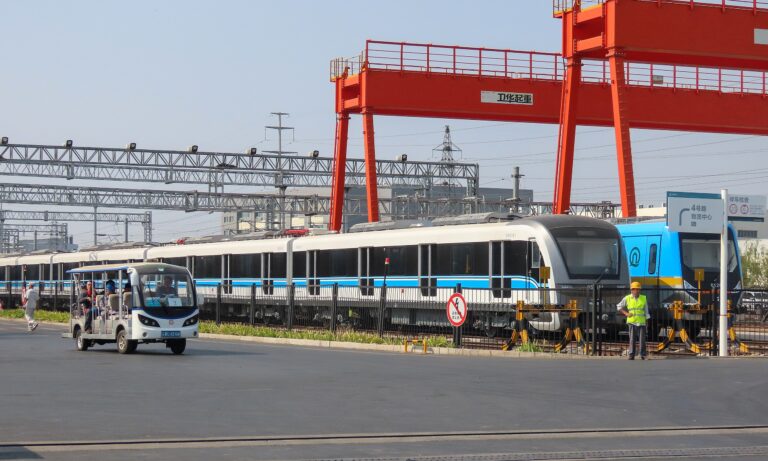
Beijing has recently shown readiness to weaponize supply chains where it has an advantage, to deter rivals like the US and Europe from cutting off access to key technologies amid intense geostrategic competition.
Chinese leaders appear intent on consolidating China’s dominance over its own chokepoints – so-called “stranglehold” (卡脖子) technologies” where it can make itself indispensable. In 2020, China’s President Xi Jinping remarked that the country “must tighten international production chains’ dependence on China, forming a powerful countermeasure and deterrent capability against foreigners who would artificially cut off supply [to China].”
Export controls – controlling the export of designated items to certain destinations or entities – are among the tools Chinese policymakers can use to protect military, economic, technological, and industrial security. China’s export control policy has evolved rapidly over the past few years. From Beijing’s perspective, controlling exports can serve a range of objectives beyond preventing technology “leakage” from civilian to military use. They can project a credible threat of retaliation, deter other countries from diversifying supply chains away from China, or signal China’s stance on geostrategic issues.
For Beijing this is mainly but not exclusively defensive posturing. It is a long game that liberal market economies would be wise to take seriously. Rather than abruptly pulling the plug on certain exports, China’s government is gradually sharpening an instrument through which to better control global tech supply chains and pursue a range of other goals.
Mineral Export Controls: China’s Ace in the Chip War
Chinese export controls came into focus in summer 2023, when China’s Ministry of Commerce (MOFCOM) announced new licensing requirements on the export of gallium and germanium, both critical minerals used in semiconductor manufacturing. The timing prompted some to characterize it as a response to the Dutch government’s new export restrictions – under pressure from the US – on products of equipment maker ASML, a major supplier of chipmaking tools to China. And retaliation it was – just not in a simple, tit-for-tat manner, and likely not aimed at that target.
Despite frustration among US officials with Beijing’s longstanding practice of economic coercion, in this case, China’s leaders would likely assert they were issuing a measured response to a muscular strategy by the Biden administration to contain China’s technological progress. Germanium is used in fiber optics and solar panels, while gallium finds applications in consumer electronics, 5G telecommunication infrastructure, and LED displays. Crucially, though, both are key for the aerospace and defense industries.
If the past months are any indication, it is plausible that the gallium and germanium controls – which do not constitute an export ban – are chiefly aimed at US companies. In May, the Chinese government deemed the products of US memory chipmaker Micron to pose an unacceptable risk to its domestic critical information infrastructure. Earlier in the year, it had added defense contractors Lockheed Martin and Raytheon to its Unreliable Entities List – companies China marks for punitive action. Just as Washington’s export controls seek to kneecap its military modernization by curtailing China’s capabilities in advanced node semiconductors, artificial intelligence, and supercomputers, Beijing is now moving to weaponize strategic defense minerals.
Shoring up China’s Industrial Dominance from Batteries to Solar Panels
Another function of export controls for China is to prevent others from building alternative supply chains that threaten its industrial and technological leadership. The European Union, the United States and others have grown uneasy with China’s dominance in the value chains of many products and technologies on which they rely for their low-carbon transition, such as batteries, high-performance magnets, electric vehicles (EVs), solar photovoltaic (PV) modules, and fuel cells. For China, losing this indispensability in clean tech would mean seeing its strategic and geoeconomic leverage eroded.
It follows that if G7 economies want to “de-risk” from China, Beijing will not let them do so easily with raw materials and technology it supplies. China enjoys a strong upstream advantage in many areas, like graphite, of which it is the world’s top producer and exporter. In October, MOFCOM announced some changes to existing dual-use licensing requirements for some types of graphite—in the past, China reportedly already withheld some graphite exports from Swedish producers of lithium-ion battery cells. The new measures specify synthetic graphite, which is key for battery production, coming weeks after the European Commission announced an anti-subsidy investigation into imports of battery EVs from China. Retaliation and the defense of industrial interests can go hand in hand.
Crucially, supply chain security goes beyond raw materials. It also includes the technology and intellectual property required in mining, refining, and manufacturing processes. In proposed amendments to its Catalogue of Technologies Prohibited and Restricted from Export, yet to be released in a final version, Chinese authorities are mulling new licensing requirements for technology needed to make solar wafers for PV modules. The changes also include potential controls on automotive LiDAR – light sensors used for mapping and navigating – as well as on technology used to process and refine rare earths and manufacture magnets from them.
A Flexible and Evolving Tool
Beijing also uses export controls more creatively. In 2020, the same catalogue was amended to, among other things, restrict exports of recommender systems – algorithms that can be used to push online content based on data analytics and artificial intelligence. Coming shortly after the Trump administration ordered China’s Bytedance to divest from its US shares in subsidiary TikTok or face a ban, the move seemed at least partly aimed at preventing this sale.
More recently, as Beijing has drawn criticism from the West amid evidence it is giving material support to Russia’s invasion of Ukraine, MOFCOM announced it would restrict exports of drones and drone-related equipment to “demonstrate our stance as a responsible major country.” The ministry explicitly cited Ukraine, showing that Beijing hopes export controls will serve a signaling purpose and defuse the risk of sanctions or other countermeasures from Europe.
Implications for Europe
Chinese policymakers seem to view export controls as a versatile instrument. Xi is relentlessly expanding the Chinese Communist Party’s definition of national security, consistent with the party’s longstanding preoccupation with staying in power. But it also reflects an ever more paranoid perception of threat. As such, predicting how Beijing may mobilize its evolving arsenal of defensive and retaliatory measures can be difficult for foreign actors. Still, viewing China’s use of export controls through the lens of its defensive core interests may help policymakers and businesses figure out where it may hit next and devise appropriate mitigation strategies.
Some Chinese export controls will have more bark than bite, and weaponizing export licenses may end up hurting China’s interests long-term in areas where it still relies on foreign inputs, or where alternative sources of supply exist. Regardless, European governments must prepare for Chinese decisions based on interlocking national security, industrial and technology policy objectives. Considering the EU’s dependence on China to supply critical inputs for its digital and green transitions, strategies should focus not only on opening alternative sources for critical raw materials, but also on developing technological capabilities and identifying areas where China relies on Europe and partners. China wants to remain indispensable. Perhaps Europeans should take a page from this strategy.
Written by
Rebecca Arcesati
RebeccaArcesatiRebecca Arcesati is a Lead Analyst at MERICS. Her research focuses on China’s technology and digital policy as well as Europe-China innovation relations.


